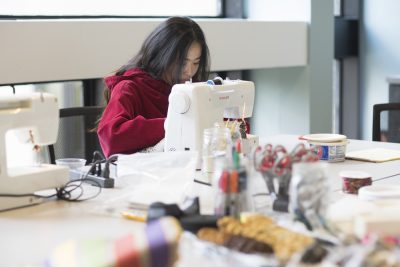
Many American consumers don’t know how or where their clothes were made. Fast fashion retailers like H&M and Forever 21, which are popular with college students for their low prices and trendy pieces, have received negative press for poor labor conditions in their factories.
In an attempt to abate this ignorance, Boston University students Priya Krishnamoorthy and Xiaoyu Yao, created Green Your Wardrobe, a three-day event series from April 27 to 29, offering workshops, screenings and panel discussions.
“After watching the film ‘The True Cost’ showcasing the Rana Plaza [factory collapse] disaster in Bangladesh, I did some more research and realized how unethical the fashion industry is. I wanted to do something about it and to tell the story of what’s hidden behind the fashion,” Krishnamoorthy explained.
A workshop on Friday evening screened “The True Cost.” Like Krishnamoorthy, many attendees were touched by the information presented.
“I thought the documentary ‘The True Cost’ was eye-opening to how much harm fast fashion causes in other countries,” said Amber Stout, a graduate student in BU’s Metropolitan College. “From the environmental waste to the poor working conditions, the film was a good reminder of why it’s important to buy less, buy second hand or buy from sustainable fashion businesses.”
Following the screening, the audience heard a panel discussion with DoneGood co-founder Cullen Schwarz, Factory45 CEO Shannon Lohr, costume technician Tazzy Cole and DL Lundberg, founder of MFC Tie-Dye.
“The panel of experts in the field complimented the film nicely by offering solutions to the extreme despair and harm shown in the documentary and went deeper into conversations about the people behind the products,” Stout said. “The event reaffirmed my preference of thrift shopping for clothes and made me want to research further into eco-friendly fashion options.”
In addition to Friday’s discussion, Kate Black, blogger and author of “Magnifeco,” gave a talk on Saturday about making the transition to sustainable living.
“She talked about how you can’t just stop buying [everything], but that you have to care for what you [do] buy,” Krishnamoorthy said. “Buy consciously and care for it as long as it’s there … Buy when it means something to you. I thought it was great advice.”
Yao said they wanted to avoid being didactic.
“We wanted students to be able to make something real out of their hands and not only take back what they made, but also with knowledge,” Yao said. “The ideal is that they leave wanting to go sustainable. [These workshops] can provide basic life lessons.”
Available hands-on workshops included “Sewing 101,” which taught basic mending skills, and a guide to repurposing excess fabric called “Say it with a Bowtie!” The turnout for many of these workshops wasn’t as high as expected.
“There were very few people that were able to attend, but all of the teachers there were really nice people and very educated about the subject,” said Ruby Rosenberg, a junior in the College of Communication.
The event was designed to coincide with Fashion Revolution Week, Rosenberg explained.
“It seemed like poor timing with the last week of classes, but they were actually trying to align the workshops with Fashion Week and were hoping to encourage everyone, but especially those interested in the fashion industry, to become more sustainable when it comes to their wardrobes,” she said.
Next year, Krishnamoorthy and Yao are planning on hosting toward the beginning of the fall semester, with hopes that students will have more time to attend.
With help from powerful speakers and sewing tutorials, Yao said they hope students will think more before swiping their cards.
“Think about what you’re wearing. Think about how much it costs,” Yao said. “Think about the people behind it. Don’t be overwhelmed by that. Just think, ‘How can I make it better?’”

















































































































Ty Furman • May 9, 2018 at 4:22 pm
Thanks for the article. Just want to make it clear that the entire program was sponsored by the BU Arts Initiative – Office of the Provost.
Satish • May 2, 2018 at 10:47 am
A good article…we all need to do our bit to help!